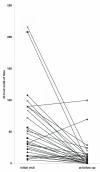Cyclic Vomiting Syndrome in 41 adults: the illness, the patients, and problems of management
- PMID: 16368014
- PMCID: PMC1326207
- DOI: 10.1186/1741-7015-3-20
Cyclic Vomiting Syndrome in 41 adults: the illness, the patients, and problems of management
Abstract
Background: Cyclic Vomiting Syndrome (CVS) is a disorder characterized by recurrent, stereotypic episodes of incapacitating nausea, vomiting and other symptoms, separated by intervals of comparative wellness. This report describes the clinical features, co-morbidities and problems encountered in management of 41 adult patients who met the diagnostic criteria for CVS.
Methods: This is a retrospective study of adults with CVS seen between 1994 and 2003. Follow-up data were obtained by mailed questionnaires.
Results: Age of onset ranged from 2 to 49 years. The duration of CVS at the time of consultation ranged from less than 1 year to 49 years. CVS episodes were stereotypic in respect of their hours of onset, symptomatology and length. Ninety-three percent of patients had recognizable prodromes. Half of the patients experienced a constellation of symptoms consisting of CVS episodes, migraine diathesis, inter-episodic dyspeptic nausea and a history of panic attacks. Deterioration in the course of CVS is indicated by coalescence of episodes in time. The prognosis of CVS is favorable in the majority of patients.
Conclusion: CVS is a disabling disorder affecting adults as well as children. Because its occurrence in adults is little known, patients experience delayed or mis-diagnosis and ineffectual, sometimes inappropriately invasive management.
Figures






References
-
- Fleisher DR, Matar M. The Cyclic Vomiting Syndrome: A report of 71 cases and literature review. Journal of Pediatric Gastroenterology and Nutrition. 1993;17:361–369. - PubMed
-
- Li BK. Cyclic Vomiting: The Pattern and Syndrome Paradigm. Journal of Pediatric Gastroenterology and Nutrition. 1995;21:S6–S10. - PubMed
-
- Li BK, Balint JP. Cyclic Vomiting Syndrome: Evolution of our understanding of a brain-gut disorder. Advances in Pediatrics. 2000;47:117–160. - PubMed
-
- Li BK. Cyclic Vomiting: New understanding of an old disorder. Contemporary Pediatrics. 1996;13:48–62.
-
- Ravelli AM. Cyclic vomiting syndrome: new clues for an old disease. Gastroenterology International. 2001;14:65–72.
MeSH terms
LinkOut - more resources
Full Text Sources
Medical
Miscellaneous

